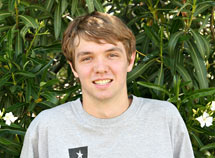
Handy Links
SLAC News Center
SLAC Today
- Subscribe
- Archives: Feb 2006-May 20, 2011
- Archives: May 23, 2011 and later
- Submit Feedback or Story Ideas
- About SLAC Today
SLAC News
Lab News
- Interactions
- Lightsources.org
- ILC NewsLine
- Int'l Science Grid This Week
- Fermilab Today
- Berkeley Lab News
- @brookhaven TODAY
- DOE Pulse
- CERN Courier
- DESY inForm
- US / LHC
SLAC Links
- Emergency
- Safety
- Policy Repository
- Site Entry Form

- Site Maps
- M & O Review
- Computing Status & Calendar
- SLAC Colloquium
- SLACspeak
- SLACspace
- SLAC Logo
- Café Menu
- Flea Market
- Web E-mail
- Marguerite Shuttle
- Discount Commuter Passes
-
Award Reporting Form
- SPIRES
- SciDoc
- Activity Groups
- Library
Stanford
Around the Bay
People: Bryce Cronkite-Ratcliff
In seventh grade, Bryce Cronkite-Ratcliff was asked to make a project for his school's science fair. Instead of settling for standbys like the baking-soda volcano or the balloon-propelled rocket, Cronkite-Ratcliff got a laser and reproduced Thomas Young's classic double slit experiment, demonstrating light's wave-like properties in his parents' hallway. The next year he built a replica of the mirror system Archimedes allegedly used to set fire to the Roman Fleet during the Siege of Syracuse.
This went on throughout junior high and continued into high school, the projects becoming more involved each year. For his project this spring as a senior at Crystal Springs Uplands high School in Hillsborough, California, Cronkite-Ratcliff worked with SLAC Senior Staff Scientist Uwe Bergmann to explore the bonding configurations of water molecules. The project, titled "The Nonhomogeneous Intermolecular Bonding Structure of Liquid Water: An X-ray Study," won Grand Prize in Physical Science at the 2009 Bay Area Science Fair, earning Cronkite-Ratcliff a spot at the International Science Fair in Reno, where he received the Third Place Grand Award.
"It was kind of a party," Cronkite-Ratcliff said of the event. "A science party."
Cronkite-Ratcliff's involvement at SLAC began several years earlier, when he visited the lab after hearing about Bergmann's work on the Archimedes Palimpsest. At the end of the visit, Cronkite-Ratcliff asked whether he could work with Bergmann as an intern. Bergmann agreed, but under one condition: Cronkite-Ratcliff had to wait until he turned 16. (Editor's note: SLAC has since raised the minimum age for interns to 18.)
Since starting the internship, Cronkite-Ratcliff has worked on several imaging projects, including Bergmann's study of the Thermopolis Archaeopteryx fossil in 2008. The internship not only gave Bergmann an extra set of hands in the lab, but gave Cronkite-Radcliff direct experience in doing physics.
"I've been working with some really, really enthusiastic people," he said. "Being at the e beamline and with these scientists who are so passionate about their work is really kind of inspiring. It's shown me that it's something that I'd like to do."
Cronkite-Ratcliff grew up in a science-centric household—his father is a physicist and his mother a health scientist. He attributes his own interest in part to that, and in part to the way that science allows him to bring together information from seemingly unrelated fields. His interdisciplinary leanings were evident at his May 27 presentation for the SLAC Association for Student Seminars, "XRF Imaging: Dinosaurs, Brains and Archimedes."
As much as Cronkite-Ratcliff enjoys doing science, he enjoys talking about it and sharing his enthusiasm with others. As the founding member of the Cutting Edge Science club at Crystal Springs Uplands, Cronkite-Ratcliff promoted science by organizing field trips to SLAC and bringing in speakers from around the Bay Area. Among the most successful of these events was a Tesla Coil presentation, which drew, by Cronkite-Ratcliff's estimates, about 80 percent of the student body. The group also wrote news briefs on current science research, posting them around the school, keeping students informed on topics ranging from hemispherectomy to invisibility.
Aside from science, Cronkite-Ratcliff occupies his time playing guitar and piano, and occasionally builds computers. In high school he competed in track, swimming and cross country, serving as the captain of the cross country team his senior year. He starts at Stanford in September, and is looking forward to developing his interests through his coursework there.
He's even thinking about enrolling in shop, hoping to develop skills in construction and design. He probably won't be building any more burning mirrors though. Ever since working on that project in eighth grade, Cronkite-Ratcliff has viewed the Archimedes mirror legend with a bit of skepticism.
"It's technically possible, but pretty unlikely, just because it's so bloody hard," he said. "It just wouldn't be a very efficient way to try to burn ships."
—Nicholas Bock
SLAC Today, June 10, 2009
